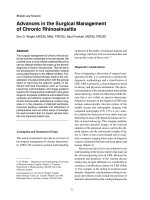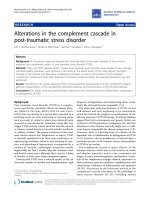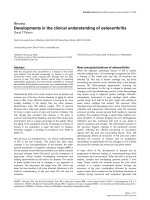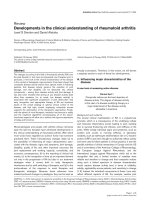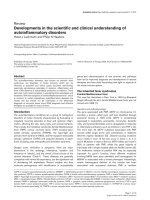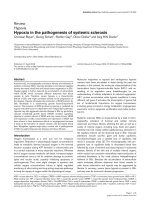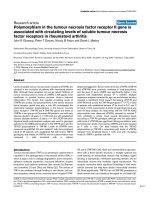Báo cáo y học: "Cetuximab in the treatment of metastatic mucoepidermoid carcinoma of the salivary glands: A case report and review of literature" doc
Bạn đang xem bản rút gọn của tài liệu. Xem và tải ngay bản đầy đủ của tài liệu tại đây (336.1 KB, 5 trang )
BioMed Central
Page 1 of 5
(page number not for citation purposes)
Journal of Medical Case Reports
Open Access
Case report
Cetuximab in the treatment of metastatic mucoepidermoid
carcinoma of the salivary glands: A case report and review of
literature
Salvatore Grisanti*
1
, Vito Amoroso
1
, Michela Buglione
2
, Anna Rosati
3
,
Roberto Gatta
2
, Claudio Pizzocaro
4
, Vittorio D Ferrari
1
and Giovanni Marini
1
Address:
1
Department of Medical Oncology, Azienda Spedali Civili, Brescia, Italy,
2
Department of Radiotherapy Oncology, University of Brescia,
Brescia, Italy,
3
Department of Neurology, University of Brescia, Brescia, Italy and
4
Department of Nuclear Medicine, University of Brescia, Brescia,
Italy
Email: Salvatore Grisanti* - ; Vito Amoroso - ; Michela Buglione - ;
Anna Rosati - ; Roberto Gatta - ; Claudio Pizzocaro - ;
Vittorio D Ferrari - ; Giovanni Marini -
* Corresponding author
Abstract
Introduction: Patients with metastatic mucoepidermoid carcinoma of salivary glands have a poor
outcome. The epidermal growth factor receptor protein is overexpressed in approximately 70%
of mucoepidermoid carcinoma patients and may represent a therapeutic target. However, whether
treatment with anti-epidermal growth factor receptor agents is effective is unclear and clinical trials
are difficult due to the rarity of the disease. Here we assessed the activity of cetuximab in
mucoepidermoid carcinoma on a molecular basis.
Case presentation: We present the case of a 40-year old Caucasian man with a mucoepidermoid
carcinoma of the major salivary glands who developed distant bone and visceral metastases despite
platinum-based chemotherapy. Epidermal growth factor receptor was overexpressed and
fluorescence in situ hybridization analysis demonstrated a chromosome 7 polysomy. The patient
was treated with the monoclonal antibody cetuximab in combination with cisplatin. After 11 doses
of cetuximab, the patient developed brain metastases but evidence of response was documented
at all extracranial metastatic sites.
Conclusion: This case report indicates that cetuximab can be active in mucoepidermoid
carcinoma and may restore sensitivity to cisplatin in platinum-treated patients. Cetuximab does not
cross the blood brain barrier and may select a metastatic clone to home the central nervous system
while responding at other sites.
Introduction
Salivary gland carcinomas (SGC) are rare neoplasms that
account for less than 1% of all human cancers. Among
SGCs, the mucoepidermoid carcinoma (MEC) is the most
common primary neoplasm, representing approximately
30% of salivary malignancies. MEC is histologically char-
acterized by a heterogeneous cellular composition,
including squamoid (epidermoid), mucus producing and
Published: 30 September 2008
Journal of Medical Case Reports 2008, 2:320 doi:10.1186/1752-1947-2-320
Received: 28 January 2008
Accepted: 30 September 2008
This article is available from: />© 2008 Grisanti et al; licensee BioMed Central Ltd.
This is an Open Access article distributed under the terms of the Creative Commons Attribution License ( />),
which permits unrestricted use, distribution, and reproduction in any medium, provided the original work is properly cited.
Journal of Medical Case Reports 2008, 2:320 />Page 2 of 5
(page number not for citation purposes)
intermediate cells. The tumor grade is defined according
to five histological features (the cystic component, neural
invasion, necrosis, number of mitoses and anaplasia) and
is important in classifying low, intermediate and high
grade neoplasms [1]. High-grade MEC is an aggressive dis-
ease with a 5-year survival rate of 25 to 30%. Although the
disease is often localized at presentation and rarely
presents with metastases, MEC tends to recur locally and
to metastasize. The initial treatment of MEC, regardless of
grade, is essentially based on surgical resection and even-
tually on adjuvant radiotherapy. Due to the rarity of the
disease, current literature is scarce and often reflects data
from small and heterogeneous series. Thus, no guidelines
are available to support the clinician's decision and the
management of metastatic MEC remains challenging.
Local recurrences not amenable to further loco-regional
treatments and metastatic disease are treated with sys-
temic chemotherapy. Single-agent or combination chem-
otherapy with cisplatin, fluorouracil and/or paclitaxel has
demonstrated activity in published series but overall
response rates are unsatisfactory and of short duration
[2,3]. Overexpression of the human epidermal growth fac-
tor receptor (HER) family of oncoproteins, HER1/epider-
mal growth factor receptor (EGFR) and HER2, has been
described in approximately 70% of salivary gland carcino-
mas including MEC and adenoid cystic carcinoma [4] but
few studies have evaluated the therapeutic relevance of an
anti-EGFR/HER2 strategy in these neoplasms. Here we
report the case of a metastatic MEC of the major salivary
glands that was refractory to platinum-containing regi-
mens and was treated with the anti-EGFR monoclonal
antibody cetuximab in combination with chemotherapy.
Case presentation
In January 2006, a 40-year-old Caucasian man underwent
a non radical resection of a high-grade MEC of the right
submandibular salivary gland at another institution. Post-
operative radiotherapy was not advised, and three months
later, the disease progressed locally and in the cervical
lymph nodes. At our institution, he was then treated with
three cycles of the paclitaxel, cisplatin, fluorouracil (TPF)
regimen; however, the disease progressed systemically
with diffuse subcutaneous neoplastic infiltrates. He there-
fore received a second line chemotherapy with carbopla-
tin and vinorelbine, but further progression occurred after
two cycles. The total body [
18
F]fluorodeoxyglucose (FDG)
positron emission tomography (PET) with fusion of CT-
scan imaging (CT-PET) documented the onset of medias-
tinal adenopathies, pleural effusion and multiple bone
lesions (Figure 1). Immunohistochemical analysis of the
primary tumor specimen showed an intense and diffuse
staining for EGFR. Cytogenetic fluorescence in situ
hybridization (FISH) analysis for the EGFR gene was neg-
ative for gene amplification but demonstrated polysomy
of the chromosome 7p12 (CEP7) with an average of five
copies (range 3–7) of chromosome 7 per cell. Analysis of
EGFR activating mutations was not performed. The
patient was then treated with cetuximab (Erbitux
®
, Merck
KGaA, Darmstadt, Germany), administered iv at a loading
dose of 400 mg/m
2
over 2 hours and then at 250 mg/m
2
weekly in combination with cisplatin (100 mg/m
2
) every
21 days as described by Herbst et al. [5]. After the second
cycle, a minor response was documented clinically and by
CT-PET, along with the onset of a WHO grade 2 classic
anti-EGFR-dependent acneiform rash; the patient contin-
ued treatment with four complete cycles of cisplatin and
11 doses of cetuximab. He also experienced WHO grade 1
paresthesias of the extremities and mild renal function
impairment. Both these side effects were attributed to cis-
platin.
In September 2006, during the treatment, the patient
experienced recurrent convulsive seizures that required
hospitalization. Neurologic examination was normal. An
EEG showed a diffuse slowing of background activity.
Rare and brief sequences of slow waves were recorded on
the central regions, bilaterally. A brain CT-scan demon-
strated the presence of at least five bilobar, parenchymal,
metastatic lesions (Figure 2). Total-body CT-PET docu-
mented a partial response (PR > 50%) of all the evaluable
extracranial metastatic lesions (Figure 1). Response was
assessed according to the RECIST criteria for radiological
CT imaging and to the 1999 EORTC recommendations for
the use of [
18
F]fluorodeoxyglucose PET.
The patient received palliative whole brain irradiation up
to 30 Gy with a daily 3 Gy fractionation and was then
returned to supportive care.
In October 2006, neoplastic pleural effusion worsened
and the patient died of rapidly progressive disease.
Discussion
The epidermal growth factor receptor (EGFR) signalling
pathway is involved in the physiological cell differentia-
tion of secretory acinus and related ducts, the functional
unit of salivary glands. Immunohistochemical studies
demonstrated different degrees of EGFR expression in sev-
eral salivary gland carcinomas, including MECs and ade-
noid cystic carcinomas (ACCs). In MECs, the percentage
of membrane staining of EGFR is approximately 77%
which is higher than in normal tissue [4]. EGFR overex-
pression is related to a poorer prognosis and a more
aggressive behaviour of the disease but its overall prog-
nostic value has not been completely established [3,6].
Thus, the development of anti-HER2 or anti-EGFR strate-
gies in salivary gland carcinomas could represent a reason-
able approach based on a biological rationale. In head
and neck squamous cell carcinoma (HNSCC), the anti-
EGFR monoclonal antibody cetuximab has been proven
Journal of Medical Case Reports 2008, 2:320 />Page 3 of 5
(page number not for citation purposes)
Total body computed tomography-positron emission tomography with [
18
F]fluorodeoxyglucose before (left panel) and after (right panel) treatmentFigure 1
Total body computed tomography-positron emission tomography with [
18
F]fluorodeoxyglucose before (left
panel) and after (right panel) treatment. Metabolically active neoplastic disease is located by high standardized uptake
value of tracer: maximum standardized uptake value values are reported for each lesion before and after treatment.
Journal of Medical Case Reports 2008, 2:320 />Page 4 of 5
(page number not for citation purposes)
to prolong overall survival in combination with radiother-
apy [7] and to enhance response rates in recurrent/meta-
static disease in combination with cisplatin or
fluorouracil [8]. Whether cetuximab can overcome plati-
num resistance in cisplatin-pretreated patients remains
controversial [9,10]. Among predictive factors of response
to anti-EGFR strategies in HNSCC, EGFR gene amplifica-
tion status is predictive of sensitivity to the EGFR-tyrosine
kinase inhibitor, gefitinib [11]. On the other hand, no
activating mutations in the EGFR gene are associated with
response to anti-EGFR strategies [12].
To date, only a few, small clinical trials have investigated
the antitumor activity of anti-EGFR targeted agents in the
salivary gland neoplasms. In a phase II study of cetuximab
monotherapy in 22 patients with recurrent/metastatic sal-
ivary gland carcinomas, including two MECs, 11 patients
had stable disease, seven of which remained progression-
free for over 6 months. None of these patients displayed
EGFR amplification or chromosome 7 polysomy [13]. In
a recent phase II study of lapatinib, a dual inhibitor of
EGFR and HER2, in recurrent/metastatic salivary gland
carcinomas, including two MECs, Agulnik et al. demon-
strated disease stabilization that lasted for more than 6
months in 36% of the patients; no objective responses
were observed. None of the patients in the cohort with
disease stabilization, however, were patients with MEC
[14].
In our report, the patient was pretreated with two lines of
platinum-containing chemotherapy with no evidence of
response; a response was only observed upon treatment
with cisplatin along with cetuximab. We do not know
whether the response was due to cetuximab alone or due
to a synergistic effect with the restoration of cisplatin sen-
sitivity. The chromosome 7 polysomy, documented in the
patient, may account for increased protein expression at
the membrane level and clinical response. However, a
clear genotype/phenotype correlation cannot be estab-
lished on the basis of only this data. Finally, a mixed pat-
tern of central nervous system (CNS) progression and
systemic response was concomitantly observed in our
patient. Such an effect is often seen in metastatic breast
cancer patients treated with trastuzumab who develop
CNS metastases while responding at different metastatic
sites. The creation of a CNS sanctuary for cancer cells
results from the inability of trastuzumab to cross the
blood-brain barrier due to its relatively high molecular
weight; this mechanism presumably also applies to cetux-
imab in different neoplastic conditions, as our case dem-
onstrates.
Conclusion
In conclusion, this case report indicates cetuximab func-
tion in a recurrent and metastatic MEC of the salivary
glands. EGFR expression is a prerequisite for cetuximab
use but EGFR gene amplification, or at least chromosome
7 polysomy, seems to be necessary for elicitation of bio-
logical activity. Our findings also emphasize the impor-
tance of CT-PET in monitoring neoplastic diseases during
molecular targeted therapies. The inability of cetuximab
to cross the blood-brain barrier and the consequent devel-
opment of CNS metastases during treatment is a subject of
concern that requires further study.
Abbreviations
ACC: adenoid cystic carcinoma; CEP: centromeric enu-
meration probes; CNS: central nervous system; CT: com-
puted tomography; EEG: electroencephalogram; EGFR:
epidermal growth factor receptor; FDG: fluorodeoxyglu-
cose; FISH: fluorescence in situ hybridization; HER:
human epidermal growth factor receptor; HNSCC: head
and neck squamous cell carcinoma; MEC: mucoepider-
moid carcinoma; PET: positron emission tomography;
SGC: salivary gland carcinoma; TPF: paclitaxel, cisplatin,
fluorouracil; WHO: World Health Organization.
Competing interests
The authors declare that they have no competing interests.
Authors' contributions
SG was involved in the conceptual design of this study, in
the clinical management of the patient, and in the writing
and editing of the manuscript. VA was involved in the
Contrast enhancement (white arrows) in brain computed tomography scan showing synchronous multiple metastases during cetuximab treatmentFigure 2
Contrast enhancement (white arrows) in brain com-
puted tomography scan showing synchronous multi-
ple metastases during cetuximab treatment.
Publish with BioMed Central and every
scientist can read your work free of charge
"BioMed Central will be the most significant development for
disseminating the results of biomedical research in our lifetime."
Sir Paul Nurse, Cancer Research UK
Your research papers will be:
available free of charge to the entire biomedical community
peer reviewed and published immediately upon acceptance
cited in PubMed and archived on PubMed Central
yours — you keep the copyright
Submit your manuscript here:
/>BioMedcentral
Journal of Medical Case Reports 2008, 2:320 />Page 5 of 5
(page number not for citation purposes)
clinical management and contributed to writing and edit-
ing of the manuscript. MB was involved in the radiation
treatment of the patient. AR performed the neurological,
clinical and instrumental examinations. RG was involved
in the manuscript editing and provided iconographic
material. CP performed and interpreted all CT-PET scan
examinations. VDF was involved in the clinical manage-
ment and contributed to the writing and editing of the
manuscript. GM supervised the entire treatment, provided
financial and administrative support and contributed in
the critical reading of the manuscript. All authors read and
approved the final manuscript.
Consent
A standard institutional informed written consent for
treatment was obtained from the patient at the beginning
of each treatment. A separate institutional informed con-
sent was obtained at the first visit, with regard to the treat-
ment of personal data and use in scientific publications
and with regard to protection of privacy according to Ital-
ian law. Written informed consent was obtained from the
patient for publication of this case report and accompany-
ing images. A copy of the written consent is available for
review by the Editor-in-Chief of this journal.
Acknowledgements
The authors wish to thank Dr. Paola Casieri for EGFR immunohistochem-
ical and FISH analyses and Prof. Alessandro Padovani and Prof. Stefano M.
Magrini for critical reading of the manuscript and useful discussion.
References
1. Goode RK, El-Naggar AK: Mucoepidermoid carcinoma. In World
Health Organization Classification of Tumours: Pathology and Genetics of
the Head and Neck Tumours Edited by: Barnes L, Eveson JW, Reichert
P, Sidransky D. Lyon, France: IARC Press; 2005:219-220.
2. Laurie SA, Licitra L: Systemic therapy in the palliative manage-
ment of advanced salivary gland cancers. J Clin Oncol 2006,
24:2673-2678.
3. Agulnik M, Siu LL: An update on the systemic therapy of malig-
nant salivary gland cancers: role of chemotherapy and
molecular targeted agents. Curr Med Chem Anticancer Agents
2004, 4:543-551.
4. Gibbons MD, Manne U, Carroll WR, Peters GE, Weiss HL, Grizzle
WE: Molecular differences in mucoepidermoid carcinoma
and adenoid cystic carcinoma of the major salivary glands.
Laryngoscope 2001, 111:1373-1378.
5. Herbst RS, Arquette M, Shin DM, Dicke K, Vokes EE, Azarnia N,
Hong WK, Kies MS: Phase II multicenter study of the epider-
mal growth factor receptor antibody cetuximab and cispla-
tin for recurrent and refractory squamous cell carcinoma of
the head and neck. J Clin Oncol 2005, 23:5578-5587.
6. Milano A, Longo F, Basile M, Iaffaioli RV, Caponigro F: Recent
advances in the treatment of salivary gland cancers: empha-
sis on molecular targeted therapy. Oral Oncol 2007, 43:729-734.
7. Bonner JA, Harari PM, Giralt J, Azarnia N, Shin DM, Cohen RB, Jones
CU, Sur R, Raben D, Jassem J, Ove R, Kies MS, Baselga J, Youssoufian
H, Amellal N, Rowinsky EK, Ang KK: Radiotherapy plus cetuxi-
mab for squamous-cell-carcinoma of the head and neck. N
Engl J Med 2006, 354:567-578.
8. Burtness J, Goldwasser MA, Flood W, Mattar B, Forastiere AA:
Phase III randomized trial of cisplatin plus placebo com-
pared with cisplatin plus cetuximab in metastatic/recurrent
head and neck cancer: An Eastern Cooperative Oncology
Group study. J Clin Oncol 2005, 23:8646-8654.
9. Chan ATC, Hsu MM, Goh BC, Hui EP, Liu TW, Millward MJ, Hong RL,
Whang-Peng J, Ma BBY, To KF, Mueser M, Amellal N, Lin X, Chang
AY: Multicenter, phase II study of cetuximab in combination
with carboplatin in patients with recurrent or metastatic
nasopharyngeal carcinoma. J Clin Oncol 2005, 23:3568-3576.
10. Vermorken JB, Trigo J, Hitt R, Koralewski P, Diaz-Rubio E, Rolland F,
Knecht R, Amellal N, Schueler A, Baselga J: Open-label, uncon-
trolled, multicenter phase II study to evaluate the efficacy
and toxicity of cetuximab as a single agent in patients with
recurrent and/or metastatic squamous cell carcinoma of the
head and neck who failed to respond to platinum-based ther-
apy. J Clin Oncol 2007, 25:2171-2177.
11. Erjala K, Sundvall M, Junttila TT, Zhang N, Savisalo M, Mali P, Kulmala
J, Pulkkinen J, Grenman R, Elenius K: Signaling via ErbB2 and
ErbB3 associates with resistance and epidermal growth fac-
tor (EGFR) amplification with sensitivity to EGFR inhibitor
Gefitinib in head and neck squamous cell carcinoma cells.
Clin Cancer Res 2006, 12:4103-4111.
12. Cohen EEW, Lingen MW, Martin LE, Harris PL, Brannigan BW,
Harselat SM, Okimoto RA, Sgroi DC, Dahiya S, Muir B, Clark JR,
Rocco JW, Vokes EE, Haber DA, Bell DW: Response of some head
and neck cancers to epidermal growth factor receptor tyro-
sine kinase inhibitors may be linked to mutations of ERBB2
rather than EGFR. Clin Cancer Res 2005, 11:8105-8108.
13. Licitra L, Locati LD, Potepan P, Crippa F, Bossi P, Bergamini C, Rinaldi
G, Liberatoscioli C, Perrone F, Losa M, Pilotti S: Cetuximab (C225)
in recurrent and/or metastatic salivary gland carcinomas
(RMSGCs): A monoinstitutional phase II study [abstract
5547]. Proc Am Soc Clin Oncol 2006, 24:64.
14. Agulnik M, Cohen EWE, Cohen RB, Chen EX, Vokes EE, Hotte SJ,
Winquist E, Laurie S, Hayes DN, Dancey JE, Brown S, Pond GR,
Lorimer I, Daneshmand M, Ho J, Tsao MS, Siu L: Phase II study of
lapatinib in recurrent or metastatic epidermal growth factor
receptor and/or erbB2 expressing adenoid cystic carcinoma
and non-adenoid cystic carcinoma malignant tumors of the
salivary glands. J Clin Oncol 2007, 25:3978-3984.


